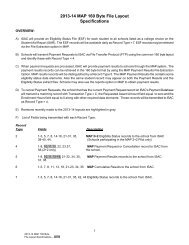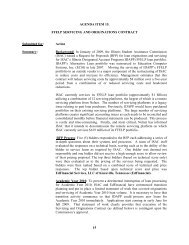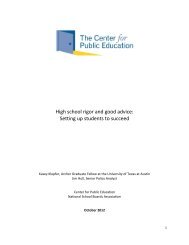MORE GUIDANCE, BETTER RESULTS?
MORE GUIDANCE, BETTER RESULTS?
MORE GUIDANCE, BETTER RESULTS?
You also want an ePaper? Increase the reach of your titles
YUMPU automatically turns print PDFs into web optimized ePapers that Google loves.
Chapter 1IntroductionOver the last 40 years, community colleges have played an increasingly important rolein postsecondary education. In the fall of 1963, community colleges enrolled under threequarters of a million students; by the 2006-2007 school year, they enrolled 6.2 million students,an increase of 741 percent. During this same time period, public and private four-year collegesand universities saw their enrollments grow by less than 200 percent. The substantially fastergrowth rate of community colleges has led them now to enroll more than one in every threepostsecondary education students. 1As the proportion of postsecondary students enrolled at community colleges has increased,so has the understanding of the challenges that these students face. Among studentswho enroll in community colleges with the intention of earning a credential or transferring to afour-year institution, only 51 percent fulfill these expectations within six years of their initialenrollment. 2 Research by MDRC and others suggests that many community college studentswant to earn a degree, but are stymied by the competing demands of work, family, and school.Institutional barriers, such as poorly tailored instruction, insufficient financial aid, or inadequatestudent services, can also impede students’ academic progress. 3 As a result, community collegesare searching for innovative programs to improve the likelihood of academic success amongtheir students.This report presents results from a rigorous study of a program designed to increaseacademic success by providing enhanced student services and a modest stipend to low-incomestudents at two community colleges in Ohio: Lorain County Community College and OwensCommunity College. Participating students were randomly assigned either to a control group,whose members received the college’s regular services, or to a program group. Program groupmembers were assigned to one of a team of counselors, with whom they were expected to meetat least two times per semester for two semesters to discuss academic progress and resolve anyissues that might affect their schooling. Program group students also could and sometimes didmeet with other counselors on the team. Each program counselor worked with far fewerstudents than did the regular college counselors, which allowed for more frequent, intensivecontact. Program group students were also eligible for a $150 stipend during each of the twosemesters, for a total of $300.1 Provasnik and Planty (2008). Enrollment data do not include students who were enrolled only in noncreditcourses.2 Hoachlander, Sikora, and Horn (2003).3 Brock and LeBlanc (2005).1












